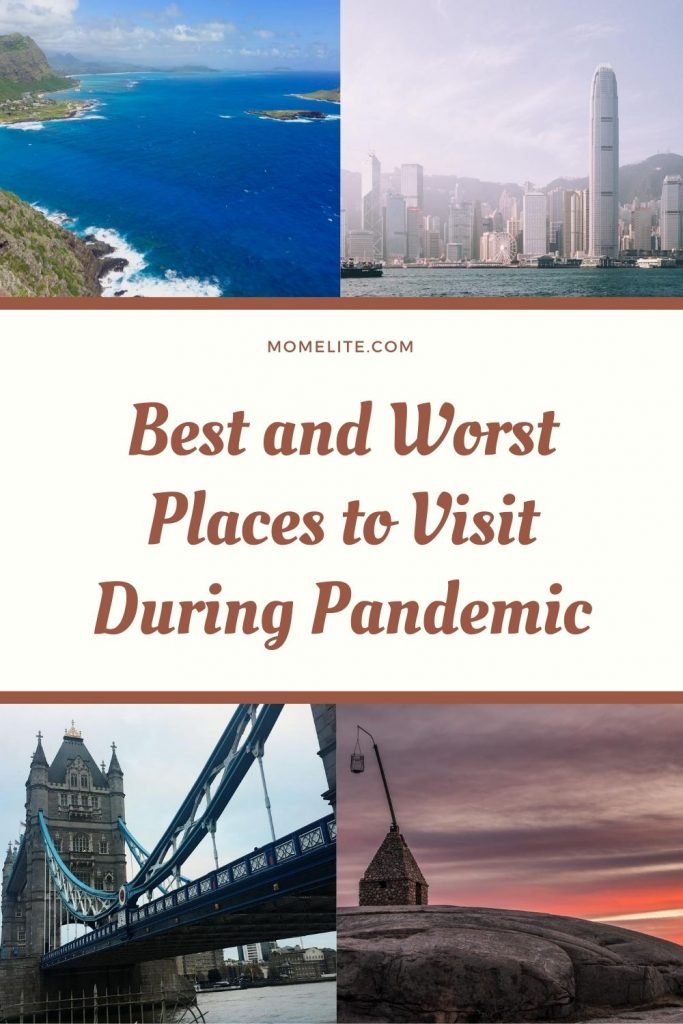
Most people all around the world have been stuck at home since March. If they haven’t been at home, they have been at least sticking close to home since traveling hasn’t been an option for most families. I decided to reach out to bloggers around the world to see what places are safe and not so safe to visit right now.
Remember if you are traveling from the United States, most countries have their borders closed to United States citizens. Be sure to check the travel restrictions for each country before you plan your trip.
Honolulu, Hawaii

Strict travel restrictions in Hawaii have kept cases of COVID relatively low in the islands so far. The governor instituted a 14-day quarantine for visitors and prohibited any non-essential travel activities. Stepping outside your hotel room for any reason other than medical care during quarantine could result in a hefty fine.
While tourism makes up a majority of Hawaii’s economy, most Hawaii residents were relieved that arrivals dropped from 30,000 per day to 500. Locals have been concerned that visitors aren’t following COVID regulations and may undermine their hard work to prevent the spread of the virus. Hawaii hospitals have limited resources for an outbreak, so containing cases is paramount.
Hawaii is still navigating the necessary tasks of both reopening tourism for the economy as well as keeping the local population safe. If a Hawaii trip is in your plans for later this year, be sure to check current Hawaii travel restrictions and follow State guidance to be a respectful, responsible visitor.
Mumbai, India

The city that flaunts the title of being the Financial Capital of India, unfortunately, holds the title of being one of the two major “Coronavirus hotspots” in India as well. Mumbai stands second in the list of regions reporting the most number of corona positive cases in India. Delhi occupies the not-so-coveted first spot.
Now you’d wonder why is this the case? Why is Mumbai not able to contain the virus spread? A major reason behind Mumbai’s inability to control virus transmission has been the failure in implementing social distancing norms. Mumbai, as you know, has a very high population density. With more than thirty thousand people living per square kilometre, it is extremely difficult to ensure effective social distancing between people.
In such a scenario, the only way in which Mumbai can flatten the curve is by developing herd immunity. Since vaccination for coronavirus has not been made, medical researchers are floating the theory that if many people contract the disease and gradually go on to build a natural immunity, then the disease can be stopped from spreading.
The Maharashtra state government, however, is leaving no stone unturned in ensuring the safety of it’s citizens. Be it implementing a strict city-wide lockdown or tracing the contacts of high-risk individuals and home quarantining them, the government is trying it’s best to reduce the spread of COVID-19.
In fact, a major reason why the number of cases being reported is increasing is because of the increased testing of people as well. On a positive note, because of the proactive work of the medical and health departments, Mumbai currently has the highest rate of recovery amongst all cities in India.The corona positive cases are continuing to rise but there is still hope. Since the rate of recovery is improving per day and the mortality rate is reducing, Mumbai is slowly but surely moving in the right direction as far as the war against coronavirus is concerned. However, for safety reasons, it’s best to avoid travelling to Mumbai for now.
Contributed by Vaibhav Mehta from The Wandering Vegetable
Hong Kong

Hong Kong is unquestionably one of the best places during an epidemic. Though as one of the first countries in the world to get COVID-19, the 7.5-million people city has kept its COVID-19 cases to less than 1,200 (at the time of writing). Only 6 people have died from contracting COVID-19, displaying competence in the medical system of Hong Kong. However, the health system isn’t the reason why Hong Kong’s number is so low, it is a combination of many efforts.
First, almost everyone is wearing a mask. Though Hong Kong’s hot climate makes wearing a mask uncomfortable, Hong Kongers know the importance of wearing one. They are not afraid of taking one for the team. Second, everyone that travels to Hong Kong gets tested. At the Hong Kong airport, a spit sample is collected from every single individual. The government then puts the people in a free 1-day hotel to wait for the results. If the result of your spit test is negative, you would then do a mandatory 14-day quarantine. This system catches all imported cases from other countries. Third, social distancing policies have been in place since the beginning of the outbreak. Every store and restaurant has temperature checks and free hand sanitizer, further decreasing the likelihood of COVID-19 spreading.
Great Britain

Great Britain is an island. As such, it would seem somewhat easier to be able to contain the spread of a virus. In fact, for example, it is over one hundred years since the last cases of rabies, except in some species of wild bat.
So what do you do with this geographical advantage? Absolutely nothing! In March when all the countries in the world began to close borders and considerably limit even the entry of citizens if not residents, the UK welcomed everyone with open arms! Not even a temperature check at the airport!
Don’t get me wrong, a lot of effort has been invested to ensure the necessary health care for anyone who needs it, and a lot of money has been invested in diagnosis, eventually reaching up to 200,000 tests per day, but prevention was the Achilles’ heel.
First, the very late lockdown was all fake. The slogan, instead of “stay at home” could have been “stay at home unless you want to go out”. Yes, you didn’t even need an excuse to go out.
London is an international Air Travel hub, but has anyone ever been checked on arrival? Or was entry restricted to people from places with high infection rates? No, only on the 9th of June, when other European countries began to reopen their frontiers to the UK, the UK decided that anyone arriving now will have to undergo 14 days of quarantine.
Of course, we will need to wait 5-10 years before we can judge which countries were successful in their battle against Covid 19, but I doubt the UK will feature highly.
Norway

Norway has been one of the European countries that has dealt with the pandemic quite well. The government decided to act quickly, and several measures were introduced that allowed the country to considerably slow down the growth of the virus. Many businesses were temporarily closed, big gatherings cancelled, and preventative policies put in place.
This also included closing the borders of Norway to external visitors. No tourists were allowed to Norway and Norwegians were encouraged to stay in the country. The mandatory quarantine was introduced for the ones arriving from abroad.
As it turned out, staying in Norway wasn’t bad at all. This was the time when we could explore more of the area near our home in Oslo and later, a bit further ahead. Thanks to that we discovered many wonderful places that can be visited on the day trips from Oslo, which we would probably not see otherwise. At the same time, we felt safe living in the country where the government had the problem under control.
Now, Norway is slowly opening back again for travelers from specific destinations, with the list of countries evaluated every 14 days. We certainly don’t want the cases to spike up again, but at the same time tourism in Norway needs to come back to its normal levels, and it’s reassuring that this is done in a responsible way.
Phenom Penh, Cambodia

Not just Phenom Penh, but Cambodia as a country has a special place in my heart. There is just so much to see and explore in this country. And along with a cheap cost of living, a business visa for Cambodia also gives you the peace of mind to have a base as a digital nomad for a long time.
Like its neighbor Vietnam, Cambodia has been able to contain the pandemic much better than many other countries like Brazil, USA so far. The reported number of cases is in three digits and no one has died yet, although as per news reports the testing has been limited only. So if you can get past that, Phenom Penh is surely worth a visit. Without tourists, places like Pha That Luang and other popular sites are empty. And you can also visit the famed Angkor Wat, without any selfie sticks in sight. If you don’t like crowds and you can get here, now is the time.
Cambodia’s land and sea borders are still closed to foreigners, but you can still fly into Phenom Penh or Sihanoukville. Make sure to check about the visa restrictions and other requirements before you plan a trip since that can change on short notice. For example, all travelers must have a medical certificate with a negative COVID-19 test result issued at most 72 hours before departure date.
The Netherlands

The Netherlands is one of the best countries to visit during this Covid pandemic. Infection numbers dropped rapidly after the first restrictions in March and have been low since then.
Museums reopened in June, but only to a limited amount of visitors. You should book your ticket for popular Amsterdam museums like the Rijksmuseum, Anne Frank and Van Gogh well in advance and for a specific time. Most restaurants only work with reservations. Face masks are only obliged in public transport. And be prepared for every restaurant, museum, hotels and even a hairdresser to ask if you have any Covid symptoms, which is also part of the new regulation.
Everyone should keep a distance of 1.5 meters unless they live together and attractions should be reorganized so visitors can actually do that. So the Zaanse Schans, a popular day trip from Amsterdam to enjoy some historical houses and windmills, now has a one-way walking route like most attractions do.
Borders have never been closed and tourists have never been banned, but it wasn’t much fun to visit the country as pretty much everything was closed. Now Dutch people are enjoying their staycation and tourists are slowly coming back to visit the Netherlands without the crowds.
By Maartje & Sebastiaan from The Orange Backpack
Florida Beaches

Florida beaches sound like a great place to take a safe and socially distanced vacation. Before you head to Florida take caution. Research your beach of choice and make sure that it isn’t a hot spot. The best beaches to visit would be places that aren’t typically known for being busy. Avoid busy places like Panama City, Miami, Orlando, St. Petersburg, Jacksonville, and Daytona Beach. Beaches like this are known for being crowded.
Your best bet for staying safe in Florida would be to find a stand alone beach house or condo to rent. Avoid large resorts and hotels. And eat in as much as possible to avoid crowds. It is possible to stay safe on vacation, you just have to adjust your normal vacation habits.


